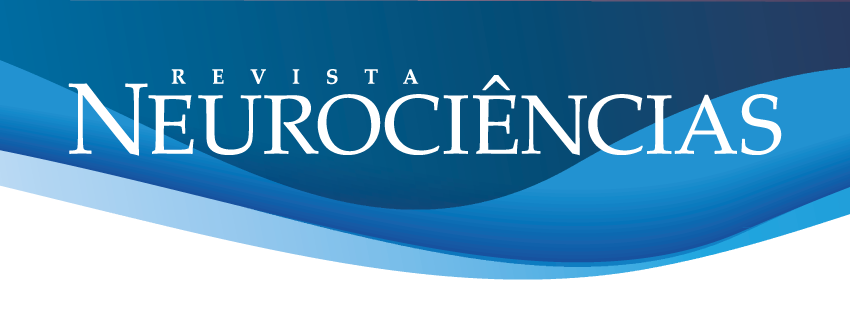Inflamação do tipo corpo estranho reduz respostas regenerativas após lesão nervosa periférica
DOI:
https://doi.org/10.34024/rnc.2019.v27.9656Palavras-chave:
crescimento axonal, inflamação, macrófago, células de Schwann, degeneração walleriana, esponjaResumo
A resposta ao corpo estranho resulta de um estímulo inflamatório persistente o qual é mediado por várias linhagens celulares. A presença de células inflamatórias influencia diretamente o comportamento das células de Schwann (CS). Nesse sentido, nós estudamos a interação entre o processo inflamatório crônico e o processo degenerativo/regenerativo no nervo. Para tanto, usamos um modelo experimental de reação de corpo estranho induzida por implantes de esponja de poliéster-poliuretano ao redor do nervo ciático de camundongos após lesão por esmagamento. Interações in vitro entre as CS e exsudatos da esponja também foram estudadas. Os resultados mostraram um grande infiltrado inflamatório com predominância de macrófagos. CS foram observadas dentro da esponja. Nos nervos envoltos por esponja foram observados reduzida expressão de NGFRp75, maior produção de colágeno, reduzido número de fibras degeneradas e da razão g, pior recuperação funcional. Além disso, os resultados in vitro demonstraram que macrófagos influenciaram a expressão de NGFRp75. Esses resultados indicam disfunção da limpeza da mielina e prejuízo na remielinização em nervos envoltos por esponja.
Métricas
Referências
Waller A. Experiments on the section of glosso-pharyngeal and hypoglossal nerves of the frog, and observations of the alternatives produced thereby in the structure of their primitive fibres. Philos Trans R Soc Lond B Biol Sci 1850;140:423-9. https://doi.org/10.1098/rstl.1850.0021
Koeppen AH. Wallerian degeneration: history and clinical significance. J Neurol Sci 2004;220:115-7.
https://doi.org/10.1016/j.jns.2004.03.008
Benowitz LI, Popovich PG. Inflammation and axon regeneration. Curr Opin Neurol 2011;24:577-83.
https://doi.org/10.1097/WCO.0b013e32834c208d
Jessen KR, Mirsky R. The repair Schwann cell and its function in regenerating nerves. J Physiol 2016;594:3521-31.
https://doi.org/10.1113/JP270874
Wong KM, Babetto E, Beirowski B. Axon degeneration: make the Schwann cell great again. Neural Regen Res 2017;12:518-24. https://doi.org/10.1113/JP270874
Chen P, Piao X, Bonaldo P. Role of macrophages in Wallerian degeneration and axonal regeneration after peripheral nerve injury. Acta Neuropathol 2015;130:605-18.
https://doi.org/10.1007/s00401-015-1482-4
Perry VH, Tsao JW, Fearn, Brown MC. Radiation-induced reductions in macrophage recruitment have only slight effects on myelin degeneration in sectioned peripheral nerves of mice. Eur J Neurosci 1995;7:271–80. https://doi.org/10.1111/j.1460-9568.1995.tb01063.x
Francesco-Lisowitz A, Lindborg JA, Niemi JP, Zigmond RE. The neuroimmunology of degeneration and regeneration in the peripheral nervous system. Neurosci 2015;302:174-203.
https://doi.org/10.1016/j.neuroscience.2014.09.027
Grindlay JH, Waugh JM. Plastic sponge which acts as a framework for living tissue. Arch Surg 1951;63:288-97.
https://doi.org/10.1001/archsurg.1951.01250040294003
Andrade SP, Fan TPD, Lewis GP. Quantitative in vivo studies on angiogenesis in a rat sponge model. Br J Exp Path 1987;68:755-66. https://www.ncbi.nlm.nih.gov/pmc/articles/PMC2013085/
Araújo FA, Rocha MA, Capettini LS, Campos PP, Ferreira MA, Lemos VS, et al. 3-Hydroxyl-3-methylglutaryl coenzyme A reductase inhibitor (fluvastatin) decreases inflammatory angiogenesis in mice. APMIS 2013;121:422-30. https://doi.org/10.1111/apm.12031
Zanon RG, Cartarozzi LP, Victório CS, Moraes JC, Morari J, Velloso LA, et al. Interferon (IFN) beta treatment induces major histocompatibility complex (MHC) class I expression in the spinal cord and enhances axonal growth and motor function recovery following sciatic nerve crush in mice. Neuropathol Appl Neurobiol 2010;36:515-34. https://doi.org/10.1111/j.1365-2990.2010.01095.x
Inserra MM, Bloch DA, Terris DJ. Functional indices for sciatic, peroneal, and posterior tibial nerve lesions in the mouse. Microsurgery 1998;18:119-24. https://doi.org/10.1002/(sici)1098-2752(1998)18:2<119::aid-micr10>3.0.co;2-0
Smith RS, Koles ZJ. Myelinated nerve fibers: computed effect of myelin thickness on conduction velocity. Am J Physiol 1970;219:1256-8. https://doi.org/10.1152/ajplegacy.1970.219.5.1256
Mayhew TM, Sharma AK. Sampling schemes for estimating nerve fiber size. II. Methods for unifascicular nerve trunks. J Anat 1984;139:59-66. https://www.ncbi.nlm.nih.gov/pmc/articles/PMC1164446/
Araujo FA, Rocha MA, Mendes JB, Andrade SP. Atorvastatin inhibits inflammatory angiogenesis in mice through down regulation of VEGF, TNF-alpha and TGF-beta1. Biomed Pharnacother 2010;64:29-34. https://doi.org/10.1016/j.biopha.2009.03.003
Cassini-Vieira P, Deconte SR, Tomiosso TC, Campos PP, Montenegro CF, Selistre-de-Araújo HS, et al. DisBa-01 inhibits angiogenesis, inflammation and fibrogenesis of sponge-indudec-fibrovascular tissue in mice. Toxicon 2014;92:81-9. https://doi.org/10.1016/j.toxicon.2014.10.007
Brockes JP, Fields KL, Raff MC. Studies on culture rat Schwann cell. I. Establishment of purified populations from cultures of peripheral nerve. Brain Res 1979;165:105-28. https://doi.org/10.1016/0006-8993(79)90048-9
Assouline JG, Bosch EP, Lim R. Purification of rat Schwann cells from cultures of peripheral nerve: an immunoselective method using surfaces coated with antiimmunoglobulin antibodies. Brain Res 1983;277:389-92. https://doi.org/10.1016/0006-8993(83)90953-8
Chomiak T, Hu B. What is the optimal value of the g-ratio for myelinated fibers in the rat CNS? A theoretical approach. PLoS One 2009;4:e7754. https://doi.org/10.1371/journal.pone.0007754
Lamaita, RM, Pontes A, Belo AV, Caetano JP, Andrade SP, Cândido EB, et al. Evaluation of N-acetilglucosaminidase and myeloperoxidase activity in patients with endometriosis-related infertility undergoing intracytoplasmic sperm injection. J Obstet Gynaecol Res 2012;38:810-6. https://doi.org/10.1111/j.1447-0756.2011.01805.x
McConnico RS, Weinstock D, Poston ME, Roberts MC. Myeloperoxidase activity of the large intestine in an equine model of acute colitis. Am J Vet Res 1999;60:807-13.
Bombeiro AL, Santini JC, Thomé R, Ferreira ER, Nunes SL, Moreira BM, et al. Enhanced immune responde in immunodeficient mice improves peripheral nerve regeneration following axotomy. Front Cell Neurosci 2016;10:151. https://doi.org/10.3389/fncel.2016.00151
Gaudet AD, Gopovich PG, Ramer MS. Wallerian degeneration: Gaining perspective on inflammatory events after peripheral nerve injury. J Neuroinflamm 2011;8:110. https://doi.org/10.1186/1742-2094-8-110
Meeker RB, Williams KS. The p75 neurotrophin receptor: at the crossroad of neural repair and death. Neural Regen Res 2015;10:721-5. https://doi.org/10.4103/1673-5374.156967
Zhan C, Ma C, Yuan H, Cao B, Zhu J. Macrophage-derived microvesicles promote proliferation and migration of Schwann cell on peripheral nerve repair. Biochem Biophys Res Commun 2015;468:343-8. https://doi.org/10.1016/j.bbrc.2015.10.097
Martini R, Fischer S, Lopez-Vales R, David S. Interactions between Schwann cells and macrophages in injury and inherited demyelinating disease. Glia 2008;56:1566–77. https://doi.org/10.1002/glia.20766
Mehanna A, Szpotowicz E, Schachner M, Jakovcevski I. Improved regeneration after femoral nerve injury in mice lacking functional T- and B-lymphocytes. Exp Neurol 2014;261:147–55. https://doi.org/10.1016/j.expneurol.2014.06.012
Koopmans G, Hasse B, Sinis N. The Role of Collagen in Peripheral Nerve Repair. In: International Review of Neurobiology. Geuna S, Tos P, Battiston B (Ed.). San Diego: Academic Press, 2009, p.363-79.
Singh N, Birdi TJ, Chandrashekar S, Antia NH. Schwann cell extracelular matrix protein production is modulated by Mycobacterium leprae and macrophage secretory products. J Neurol Sci 1997;151;13-22. https://doi.org/10.1016/s0022-510x(97)00105-6
Downloads
Publicado
Edição
Seção
Como Citar
Aprovado 2019-10-15
Publicado 2019-12-27


